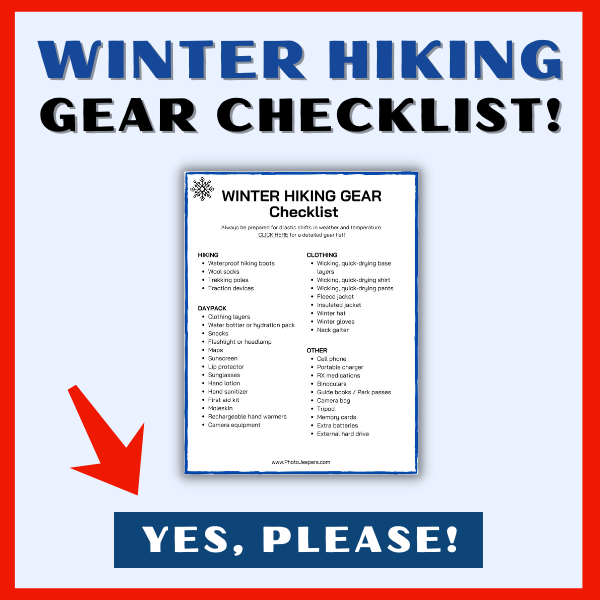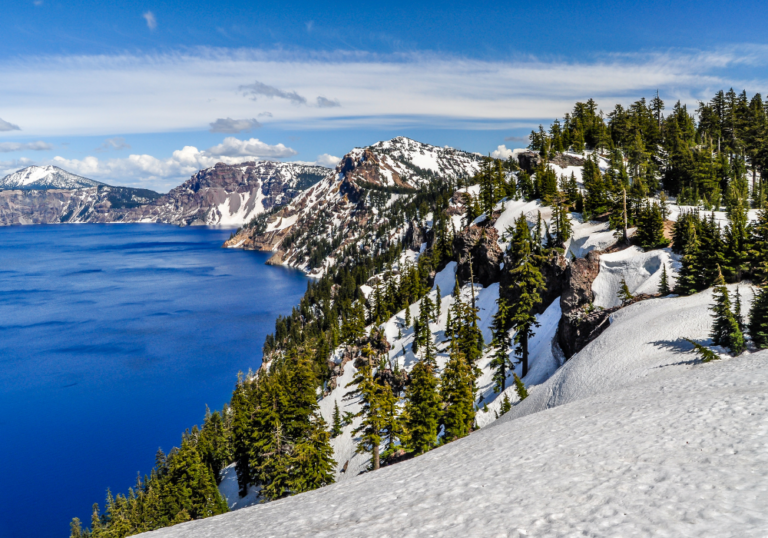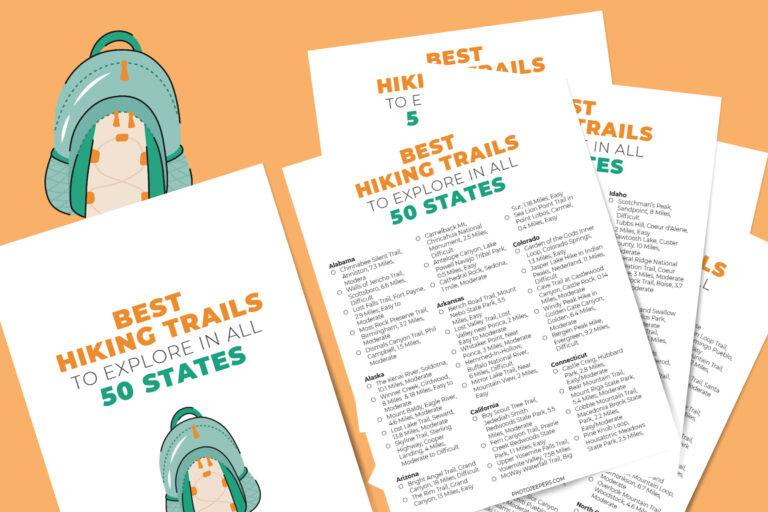Winter Hiking Gear List + Free Printable
It’s important to be prepared with winter hiking gear if you plan to hike trails during the winter season. As you make your list of US hiking ideas, here’s a list of what we recommend for hikes you plan to explore in the winter.
When preparing for a winter day hike you want footwear, clothing, and traction devices that can be used for a wide range of winter conditions. Consider the temperature, wind speed, sun, precipitation type, and surface condition for the trail you’ll hike.
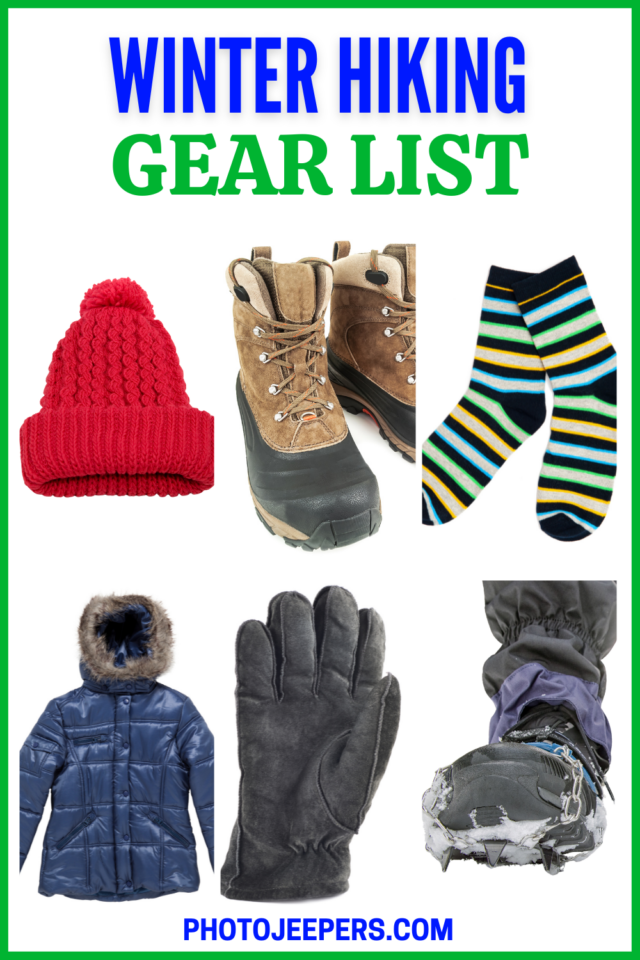
For this article, we consider winter weather conditions to be the following:
- Temperatures: 40 degrees down to 20 below zero F
- Wind speeds: up to 50 mph
- Sunlight: intense sunshine and snow glare to heavy clouds or dense forest cover
- Precipitation types: blowing snow, freezing fog, sleet, freezing rain, and rain
- Surface conditions: deep snow to bare rock, bare ground, packed trails, powder, frozen bodies of water, and soft or hard ice
Be sure to get the FREE download of the winter hiking gear checklist BELOW!

This site contains affiliate links which means WE may receive commissions for purchases made through these links. We only provide links to products we actually use and/or wholeheartedly recommend! As an Amazon Associate, we earn from qualifying purchases. Read the full Disclosure Policy.
Layering for a Winter Hike
Layers are key to any winter clothing guide, especially when hiking. As you hike, you’ll encounter a range of activity levels and body heat. While hiking you are exerting yourself and generating lots of body heat. When you stop to take a break, you’ll probably want to add layers.
When hiking in the winter it’s recommended to add clothing layers when you get cold and take off layers when you start to sweat. You don’t want to sweat in the winter because damp base layers will chill you when you stop moving.
TIP: Take off layers if you start to sweat or slow down your pace to generate less body heat.
For example, at the start of the hike you will be a base layer, fleece mid-layer, and outer layer insulated jacket and pants plus gloves, hat, warm socks, and insulated boots. After a bit hiking you’ll start to heat up and will need to take off your jacket and unzip your pants to vent body warmth.
Important: Do not wear cotton or rayon on winter hikes because it takes so long to dry.
Winter Hiking Gear List: Footwear
The winter hiking gear checklist is fairly comprehensive, and you may not need every item depending on the difficulty, location, or weather conditions of the hiking trail.
Winter Hiking Boots
For winter day hikes in snow, look for a soft insulated hiking boot that are compatible with traction devices.
Insulation thickness for winter hiking boots:
- 400g insulated hiking boots will keep you warm to 20 below zero degrees (F)
- 200g insulated hiking boots are good to about 10-20 degrees above zero degrees (F)
A 200g insulated boot works for most winter hiking. If you’ll be in temperatures below 10-20 degrees F, then get a 400g insulated boot.
Some winter hiking areas won’t have snow, like many US Southwest National Parks. You might be able to use your regular waterproof boots if the conditions don’t require additional insulation for extreme winter temperatures.
For destinations that will be EXTREMELY cold, like Yellowstone in the winter, we found Baffin Boots to be nice and warm!
Winter Hiking Socks
For winter hiking you want to invest in top-quality heavier wool socks. Make sure you have space in your boots to wiggles your toes to increase blood circulation and foot warmth.
- Darn Tough Socks are the ONLY type we buy. They are amazing and last forever!
- REI Merino wool socks are also great for winter hiking!
Winter Gaiters
High gaiters cover the open space above your boots so you don’t get snow in your boots that will make your socks wet. They also provide extra insulation below your knee.
We recommend gaiters that seal around your leg using velcro. Don’t get gaiters that close with zippers because they break!
- SHOP REI: Winter boot gaiters
- SHOP AMAZON: Winter boot gaiters
Winter Traction Devices
The traction devices you need for winter hiking vary depending on weather and trail conditions.
- Microspikes are lightweight and provide extra traction on packed snow and ice. SHOP REI: Microspikes
- Snowshoes are best for less traveled trails or after a snowfall. SHOP REI: Snowshoes
- Heavy-duty crampons are needed for steep routes covered with rock or thick ice. SHOP REI: Crampons
You may need carry one or more of these on a hike depending on the trail and conditions.
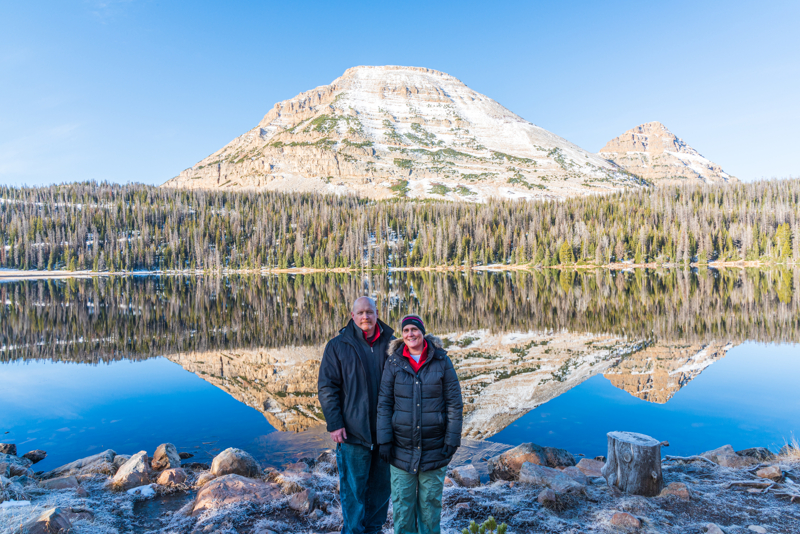
Winter Hiking Gear List: Clothing
What you wear while hiking in the winter can make or break your adventure. Here’s a list of the essentials for winter clothing for hiking.
Winter Hats
For day hikes, we recommend you pack two winter hats:
- A lightweight wool or synthetic hat is best for warmer days or if the hike will require high exertion.
- A warmer, heavier weight hat is best for later in the day or if temperatures are very low.
If hats don’t stay over your ears, or if you have your hair in a pony tail, a Buff headband can be worn under the warmer hat. Fleece BUFFS can also be used as a hat, headband or neck gaiter.
Insulated Winter Gloves
Winter mitts provide more warmth that gloves, but gloves allow individual finger movement. If it’s extremely cold, use an insulating glove inside a waterproof shell mitt to provide dexterity and warmth.
Soft-shell gloves are lighter weight and best used when body movement will heat up your hands and keep them warmer.
Fleece and leather gloves are not recommended for outdoor winter hiking.
Carry rechargeable hand warmers in your coat pocket to provide extra warmth to hands when needed. Warmers in your coat pocket also helps keep your body and camera batteries warm.
Wicking Clothing for Hiking
Wearing layers during the winter is so important. What does it mean to ‘layer’? Where do you start? And when is enough, enough?
Avoid looking like the Michelin man by following these guidelines by REI on How to Layer Clothes:
- Base layer (underwear layer): wicks sweat off your skin
- Middle layer (insulating layer): retains body heat to protect you from the cold
- Outer layer (shell layer): shields you from wind and rain
Even if you don’t wear all three layers at the outset, it’s a good idea to take all layers on every outing. You can peel off layers if things heat up, but you can’t put on layers that you didn’t bring along.
Winter Base Layer Clothing
The base layer is next-to-skin, or the underwear layer. It helps regulate your body temperature by moving perspiration away from your skin.
This base layer should be merino wool, synthetic or silk. The most important factor in choosing a base layer is that it should wick moisture away from your skin to the next highest layer of your clothing.
A base layer can be briefs, sports bras, long underwear tops and bottoms, tights and T-shirts. It’s up to you if you like it to fit snugly or loosely.
For very cold temperatures, thermal underwear is available in light-, mid- and expedition-weights. Choose the weight that best matches your activity and the temperature.
Winter Mid Layer Clothing
The insulating middle layer helps you retain heat by trapping air close to your body.
Fleece is usually the best insulating layer because it stays warm even if gets damp, and it dries fast. Fleece also breathes well, so you’re less likely to overheat in it.
The breathability of fleece is great, but the downside is the wind blows right through and takes away the warmth. That’s why you need to have a shell layer with you if you’re going with a fleece middle layer.
MID-LAYER TOPS: Fleece jackets, pullovers, or vests will keep you warm when it’s wet and wick moisture away from your skin and base layers. Add a soft-shell jacket or a down or synthetic fill vest for a bit more warmth. We have found Columbia fleece jackets to be the best!
MID-LAYER BOTTOMS: Fleece pants are breathable and form-fitting. They are water and wind resistant but not waterproof or windproof. The main function of the soft shell layer is breathability. Add soft-shell pants for a bit more warmth
Winter Outer Shell Layer Clothing
The shell or outer layer protects you from wind, rain or snow. Most allow at least some perspiration to escape; virtually all are treated with a durable water repellent (DWR) finish to make water bead up and roll off the fabric.
An outer shell is an important piece in bad weather, because if wind and water are allowed to penetrate to your inner layers, you begin to feel cold. Furthermore, without proper ventilation, perspiration can’t evaporate but instead condenses on the inside of your shell. Fit is another consideration.
Your shell layer should be roomy enough to fit easily over other layers and not restrict your movement.
WATERPROOF/BREATHABLE SHELL: The rain pant helps shield you from high winds and sustained rainfall, and traps the heat held by your mid-layer garments. Look for waterproof, breathable shell jackets with an integrated adjustable hood and at least two exterior pockets to stash hats and gloves. Find waterproof, breathable shell pants that have zips at the bottom of the leg so you can put them on or take them off without having to take off your boots.
WATER RESISTANT/BREATHABLE SHELL: The water resistant, breathable jackets and shell pants are best for light precipitation and high activity levels. They’re usually made of tightly woven fabrics (such as mini-ripstop nylon) to block wind and light rain.
SOFT SHELL: Soft shell jackets and soft shell pants emphasize breathability. Most feature stretch fabric or fabric panels for added comfort during aerobic activities. Many offer both shell and insulative properties, so they in effect combine 2 layers into 1. Soft shells include cold- and mild-weather options.
INSULATED SHELL: Insulated jackets and insulated pants offer the best protection for extreme cold. Some outer shells have a layer of insulation built in—such as fleece—making them convenient for cold, wet conditions, but not as versatile for layering in fluctuating temperatures.
The insulated jackets at Columbia are amazing! The TurboDown and OmniHeat products really do keep you warm. And that’s saying something from someone who gets cold so fast. Columbia is my go-to jacket every time!
When you’re taking a break during a winter hike and have stopped moving, it’s best to pull a big puffy insulated jacket out of your backpack and wear it over your other clothes to stay warm.
Spare Clothing for Winter Hiking
Pack spare clothing for longer winter hikes in case something gets wet (jersey, long underwear, socks, gloves, hats).
It’s also nice to have a dry layer to change into if you need to stop for an extended period of time and the clothes you are wearing are damp with sweat.

Winter Day Hiking Backpack
A good winter pack should be weather and waterproof. Make sure it fits comfortably over your bulky insulated jacket.
For winter day hikes you’ll want a 30-50 liter backpack to hold the extra clothes, food, and water you’ll need compared to other times of the year.
Look for winter packs with external attachment points and side compression straps to hold snowshoes or traction devices.
- SHOP REI: Winter Backpacks for Day Hikes
- SHOP AMAZON: Winter Backpacks for Day Hikes
Water Bottles
We like using hydration packs, but the hoses freeze in cold winter temperatures, so it’s best to carry water bottles.
You’ll want to carry wide-mouth bottles for winter hiking since the narrow-mouth are prone to freeze shut more easily.
If you don’t have room for the water bottles in your pack, use an insulated sleeve and store them upside down so the cap won’t freeze shut.
TIP: Boil your water before putting it into the bottles to stay warm during the day. Pack Propel packets to add electrolytes to your water to stay hydrated.
Healthy Snacks for Hiking
Snacks help to keep your energy levels up and stay motivated to reach the end of the trail.
- Healthy granola bar recipes
- Healthy protein snack recipes
- Gluten free snack recipes
- Vegan snack bar recipes
Hiking Compass and Maps
If you’re hiking an unfamiliar trail, it’s always a good idea to have some kind of navigation tool with you, just in case. A simple hiking maps and compass are all you need.
Providing you have cell service, your smartphone will more than likely be able to help you find your location if you get lost, but it’s better to be safe than sorry when hiking through the wilderness!
Hiking First Aid Kit
No matter whether your hike is long or short, always pack a hiking first aid kit. Make sure your first aid kit has the essentials like plasters, bandages, anti-bacterial wipes, etc.
Hiking Lighter and Whistle
Other items to pack for a winter day hike are a hiking lighter and a PLASTIC whistle.
Headlamps for Hiking
Carry a headlamp for winter hiking because there are fewer hours of daylight. Use lithium batteries for all electronic devices since they are resistant to cold temperatures.
Winter Hiking Itinerary
It’s also a good idea to write out your hiking itinerary and place one under the car seat in the parking lot before starting the hike. Also let a friend or family member know your itinerary.
Sun Protection in the Winter
Sun protection is still important for winter hiking. Use a good SPF sunscreen before hitting the trail.
Polarized sunglasses should also be worn on sunny day hikes to protect your eyes from the glare off the snow.
In the winter you’ll also want SPF rated lip balm for sun protection and wind burn.
Toilet Paper, Disposable Urination Device and Trash Bag
For women, a disposable female urination device will allow you to stand and pee, which is so nice when you’re layered with winter clothing!
Pre-assemble one pee buddy and some toilet paper in a sandwich sized ziploc. After using the buddy and toilet paper, they go back in the ziploc to pack out and throw away at the end of the hike. Seriously… these simple devices are amazing!
Camera Gear for Winter Hikes
If you like to take pictures while hiking, check out these helpful resources:
A few accessories you’ll need for winter photography are a lens warmer, spare battery, camera rain sleeve, camera cleaning kit (especially microfiber cloths).
We also recommend photographer gloves and rechargeable hand warmers for winter photography while hiking.
WINTER TIP: The chemical reactions inside the battery slow down in colder temperatures which is why they drain faster in winter. Carry one spare battery in a coat pocket. The closer to the body, the warmer it stays.

